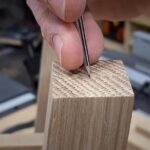Woodworking is an intricate craft that requires precision and skill. One technique that has stood the test of time is the use of rabbet cuts. Rabbet cuts are a fundamental part of woodworking, allowing for strong joints and improved aesthetics in various projects. Understanding the basics of rabbet cuts is essential for any woodworking enthusiast or professional looking to enhance their craftsmanship.
A rabbet cut, also known as a rebate or a dado, involves removing material from the edge or end of a piece of wood to create a step-like recess. This recess allows for other pieces of wood to fit snugly into the joint, resulting in increased joint strength and stability. Rabbet cuts are widely used in woodworking due to their versatility and efficiency.
Throughout history, rabbet cuts have played a significant role in woodworking techniques. The origins of this method can be traced back through predecessor techniques that gradually evolved into what we now know as rabbet cuts. From early hand tools to modern power tools, the evolution of making rabbet cuts has shaped the way woodworkers create joinery and construct various wooden structures.
In this article, we will delve into the world of rabbet cuts in woodworking. We will explore different types of rabbet cuts commonly used, such as standard rabbets, edge rabbets, groove rabbets, and lipped rabbets. We will also discuss essential tools and techniques required to make accurate rabbet cuts, as well as common challenges faced during the process and how to overcome them.
By understanding the basics of rabbet cuts in woodworking, you can elevate your craftsmanship and unlock new possibilities in your projects. Through enhanced joint strength, improved efficiency, and versatile design options, mastering the art of making precise rabbet cuts will undoubtedly enhance your woodworking skills. So let’s explore this timeless technique together and uncover its enduring significance in the world of woodworking.
Historical Significance
The history of rabbet cuts in woodworking dates back to ancient civilizations, where early woodworkers utilized rudimentary techniques to create recessed grooves in their wooden creations. While the exact origins of rabbet cuts are difficult to trace, it is believed that the technique evolved from basic methods used for jointing and connecting pieces of wood together.
One precursor to rabbet cuts can be seen in the use of dado joints by ancient Egyptians and Romans. Dados were grooves cut across the grain of a piece of wood, allowing them to interlock with matching grooves in other pieces. Over time, woodworkers began incorporating a step-down ledge into these dados, giving birth to what would eventually become known as a rabbet cut.
Throughout history, advancements in woodworking tools and techniques led to further refinement and widespread use of the rabbet cut. The invention of specialized hand tools like rabbet planes and dedicated machines such as the spindle moulder contributed to its increasing popularity among craftsmen.
Notable innovations related to rabbet cuts include the development of the rabbeting plane during the 17th century. This tool featured an adjustable fence that allowed woodworkers to create precise and consistent rabbets. Additionally, advancements in power tools during the Industrial Revolution made it easier for professionals and hobbyists alike to incorporate rabbet cuts into their woodworking projects.
Today, the rabbet cut remains a fundamental technique employed by woodworkers across various disciplines. Its historical significance lies not only in its practicality but also in how it has shaped woodworking traditions and design aesthetics throughout different eras.
Types of Rabbet Cuts
Standard Rabbet
One of the most common types of rabbet cuts in woodworking is the standard rabbet. This cut involves removing a portion of material from the edge or end of a workpiece to create a recess or groove. The standard rabbet is typically used to create joints, such as rabbet joints or lap joints, where two pieces of wood fit together seamlessly.
The versatility of the standard rabbet makes it valuable in various applications. It can be used for creating box corners, drawer bottoms, and cabinet backs. By removing a section of material, the standard rabbet allows for precise fitting and alignment between different parts of a woodworking project.
Edge Rabbet
Another type of rabbet cut commonly used in woodworking is the edge rabbet. As the name suggests, this cut is made along the edge of a workpiece rather than on its face or end. Edge rabbets are often utilized for installing glass or panels in frames and doors. The depth and width of the edge rabbet can be adjusted to accommodate different thicknesses and materials.
By incorporating an edge rabbet, woodworkers can securely hold materials within a frame while maintaining a clean and flush appearance. This type of rabbet cut provides structural support and prevents movement or shifting within the frame.
Groove Rabbet
Groove rabbets offer yet another application in woodworking projects. Unlike other types of cuts that remove material from an external surface, groove rabbets involve cutting grooves into an internal surface, such as a board’s face or edge. These grooves are commonly used to accommodate panels, shelves, or other components within furniture pieces like cabinets.
The groove created by this type of rabbet cut provides a channel for inserting panels securely while allowing for expansion or contraction due to changes in humidity. The depth and width of the groove can be adjusted based on the thickness of the panel or component being inserted. Groove rabbets offer flexibility in design and allow for the easy adjustment or replacement of panels as needed.
Lipped Rabbet
Lipped rabbet cuts are a unique variation that combines elements of both rabbet cuts and dados. In this type of cut, an additional lip or ledge is included along the edge or surface within the recess created by the rabbet cut. Lipped rabbets are often utilized for framing doors or adding decorative elements to woodworking projects.
The lip provides added strength and stability to the joint, reducing any potential gaps between components when they are joined together. Lipped rabbet cuts can also enhance the visual appeal of a piece by creating defined edges or highlighting certain design elements. This type of cut requires precise measurements and careful execution but adds a distinctive touch to woodworking projects.
By understanding these different types of rabbet cuts, woodworkers can leverage their various applications to achieve greater precision and quality in their projects. Whether it’s creating joints, accommodating panels, adding support, or enhancing aesthetics, rabbet cuts offer versatility and functionality in woodworking.
Tools and Techniques
Making precise and accurate rabbet cuts in woodworking requires the use of specific tools and techniques. These tools are essential for achieving clean and professional-looking rabbet joints. Some of the key tools commonly used in making rabbet cuts include:
- Table Saw: A table saw is often considered the go-to tool for making rabbet cuts. It allows woodworkers to easily adjust the width and depth of the cut, ensuring precision and consistency.
- Router: Routers equipped with a straight-cutting bit can be used to create rabbet cuts, especially for edge rabbets or lipped rabbets. The versatility of routers makes them suitable for both small-scale projects and larger pieces of furniture.
- Rabbeting Plane: A specialized hand plane designed specifically for creating rabbet cuts, the rabbeting plane is an invaluable tool in traditional woodworking. It allows woodworkers to make precise adjustments to the depth and width of the cut, resulting in clean and accurate joints.
- Dado Blade Set: A dado blade set can be installed on a table saw to create wider grooves for groove rabbets. This versatile tool is also useful in other woodworking applications, such as cutting dadoes or tenons.
When it comes to techniques for making rabbet cuts, there are several approaches depending on the chosen tool and desired outcome:
- Step-by-Step Guide: For beginners or those new to woodworking, following a step-by-step guide can be beneficial in understanding how to make accurate rabbet cuts using different tools. These guides typically provide detailed instructions on setup, measurements, and cutting techniques.
- Test Cuts: Before making final cuts on your workpiece, it’s recommended to make test cuts on scrap material with similar properties. This allows you to fine-tune your technique and ensure that the final result meets your expectations.
- Jig Usage: Utilizing jigs or fixtures can greatly improve the accuracy and repeatability of rabbet cuts. Jigs often act as guides for making precise cuts, ensuring consistency throughout the project.
- Safety Precautions: It is crucial to prioritize safety when working with tools for making rabbet cuts. Always wear appropriate personal protective equipment (PPE), such as safety glasses and gloves, and follow manufacturer instructions for tool usage.
In summary, mastering the art of making rabbet cuts in woodworking requires a combination of the right tools and techniques. Whether using a table saw, router, rabbeting plane, or dado blade set, each tool has its own advantages and applications. Following step-by-step guides, performing test cuts, utilizing jigs, and prioritizing safety are all essential practices for achieving accurate and professional rabbet joints in woodworking projects.
| Tool | Common Usage |
|---|---|
| Table Saw | Making precise width and depth adjustments for rabbet cuts |
| Router | Create edge rabbets or lipped rabbets with versatility |
| Rabbeting Plane | Precise adjustments to depth and width for clean joints |
| Dado Blade Set | Cutting wider grooves for groove rabbets or other woodworking applications |
Advantages of Rabbet Cuts in Woodworking
One of the key advantages of rabbet cuts in woodworking is the enhanced joint strength and stability that they provide. By cutting a groove along the edge or end of a piece of wood and fitting another piece into it, rabbet cuts create a strong and secure bond.
This type of joint is particularly useful in applications such as drawer construction, where durability and weight-bearing capacity are essential. The interlocking nature of rabbet cuts ensures that the pieces stay securely connected even under stress or pressure.
Additionally, rabbet cuts contribute to increased efficiency in woodworking tasks. By creating a precise recess for another piece to fit into, rabbet cuts facilitate accurate and seamless assembly. This reduces the need for excessive measuring and fitting, saving both time and effort in the woodworking process. Whether it’s constructing furniture, cabinetry, or other intricate woodworking projects, incorporating rabbet cuts can streamline the overall production process.
Beyond their functional benefits, rabbet cuts also offer improved aesthetics and versatility in design. The flush surface produced by joining two pieces with rabbet cuts creates a clean look without any protruding edges. This allows for seamless integration of various components in furniture or other wooden structures. Furthermore, since rabbet cuts can be made on both the edge or end grain of wood, they can be used to achieve different design effects depending on the project requirements.
| Advantages |
|---|
| Enhanced joint strength and stability |
| Increased efficiency in woodworking tasks |
| Improved aesthetics and versatility in design |
Practical Applications
Rabbet cuts are widely used in woodworking for a variety of practical purposes. This section will explore real-life examples of how rabbet cuts are applied in different woodworking projects, showcasing their versatility and functionality.
A. Case studies of furniture pieces that feature prominent rabbet cuts: One notable example of rabbet cuts in furniture design is the usage of rabbeted joints in drawers.
Rabbets are commonly used to create sturdy and reliable connections between the sides and back panels of a drawer, resulting in a seamless and durable piece of furniture. Additionally, rabbet cuts can be found on the edges of tabletops or cabinet doors, allowing them to fit snugly into their respective frames for a polished and professional finish.
B. Exploration of rabbet cuts in cabinetry and woodworking joinery: In the world of cabinetry, rabbet cuts play an integral role. For instance, when constructing cabinets or bookcases, rabbets are often made on the backs or sides to enhance structural integrity while providing a neat appearance. Furthermore, joining techniques such as tongue-and-groove joinery often incorporate rabbets to create tight-fitting connections between wooden panels.
C. Examples of practical applications like picture frames or door frames: Rabbet cuts find frequent application in creating picture frames or door frames. Picture frames require precise mitered corners with matching rabbets cut along the inner edges. These rabbets allow space for securely holding artwork or photographs along with glass or acrylic inserts to protect them.
In door frame construction, particularly for inset doors like those commonly seen in traditional cabinetry, lipped rabbet cuts play an important role. The lipped portion provides necessary support and surface area for attaching hinges while ensuring proper alignment and smooth operation.
Overall, these practical applications demonstrate how rabbet cuts contribute to the functionality and aesthetic appeal of various woodworking projects. By carefully considering the design and purpose of a piece, woodworkers can effectively utilize rabbet cuts to enhance their creations.
Common Mistakes to Avoid When Making Rabbet Cuts in Woodworking
When embarking on woodworking projects that involve rabbet cuts, it is important to be aware of common mistakes that beginners may encounter. By understanding these potential errors and learning how to prevent or rectify them, woodworkers can achieve accurate and precise rabbet cuts.
One common mistake when making rabbet cuts is not measuring properly. Accurate measurements are crucial for achieving tight-fitting joints and ensuring the overall structural integrity of the project. It is important to measure twice and cut once, taking into account the width, depth, and length of the rabbet cut.
Another mistake to avoid is not using the appropriate tools for the job. Different types of rabbet cuts may require specific woodworking tools such as a table saw, router, chisel, or dado blade. It is essential to use the right tool for the desired type of rabbet cut in order to achieve clean and accurate results.
Additionally, inadequate clamping or securing techniques can lead to errors when making rabbet cuts. Failing to securely hold the workpiece in place during the cutting process can result in imprecise cuts or even accidents. Using clamps or other methods to stabilize and secure the wood ensures greater control and accuracy when creating rabbet cuts.
To avoid these common mistakes, there are several tips and tricks that woodworkers can follow. Firstly, it is recommended to practice making test cuts on scrap pieces of wood before attempting them on actual project materials. This allows for fine-tuning techniques and getting familiar with specific tools.
Furthermore, maintaining a steady pace while cutting and avoiding rushing through the process will help ensure precision in creating rabbet cuts. Taking one’s time allows for greater attention to detail and reduces the likelihood of errors.
Lastly, regularly inspecting tools for sharpness and keeping them properly maintained can greatly contribute to successful rabbet cuts. Dull blades or worn-out bits could lead to uneven or messy cuts, so it is important to sharpen or replace them when necessary.
By being aware of common mistakes and implementing these tips and tricks, woodworkers can navigate the challenges of making rabbet cuts with greater ease and accuracy. This will ultimately result in high-quality woodworking projects that showcase the craftsmanship and precision of rabbet cuts.
Expert Advice
When it comes to mastering the art of rabbet cuts in woodworking, there is no better source of knowledge than experienced woodworkers who have honed their skills over years of practice and experimentation. These experts offer valuable insights into the importance of rabbet cuts, their favorite techniques or tools for making precise cuts, and address commonly asked questions and concerns related to this woodworking technique.
Professional woodworkers’ perspectives on the importance of rabbet cuts
Experienced woodworkers unanimously agree that rabbet cuts are an essential technique in woodworking due to their ability to enhance joint strength and stability. According to these experts, rabbet cuts create a secure fitting between two pieces of wood, minimizing the chances of them separating or coming apart.
This makes rabbet cuts especially useful in projects such as drawer construction, where a sturdy joint is crucial for durability. The experts highlight that by incorporating rabbet cuts into woodworking projects, they can achieve a more professional finish and ensure long-lasting furniture pieces.
Sharing favorite techniques or tools for making rabbet cuts
When it comes to making accurate and precise rabbet cuts, experienced woodworkers often have their own preferred techniques and tools. Some professionals recommend using a router with a straight bit for creating standard rabbets, while others prefer using hand planes to achieve meticulous control over the depth and width of the cut.
Additionally, dado blades on table saws are also frequently mentioned as effective tools for making groove rabbets. Woodworkers emphasize the importance of having sharp blades or bits to ensure clean and smooth results while working with different types of wood.
Addressing commonly asked questions and concerns related to rabbet cuts
Through years of experience, expert woodworkers have encountered numerous questions and concerns regarding rabbet cuts. One common question that arises is the appropriate depth and width of a rabbet cut for specific woodworking projects. In response, these experts suggest considering the thickness of the material being joined and the overall strength required for the joint, as these factors will determine the dimensions of the rabbet cut.
Another frequently asked question revolves around properly aligning multiple rabbet cuts to ensure a snug fit. The experts advise using precision marking tools, such as story sticks or marking gauges, to accurately transfer measurements and maintain consistency throughout the project. They also emphasize the importance of test-fitting regularly during the cutting process to ensure a proper fit before final assembly.
Conclusion
In conclusion, rabbet cuts hold a significant place in the world of woodworking due to their versatility and craftsmanship. Throughout this article, we have explored the basics, history, types, tools and techniques, advantages, practical applications, common mistakes to avoid, and insights from experienced woodworkers regarding rabbet cuts.
Rabbet cuts have proven themselves to be essential in achieving enhanced joint strength and stability in woodworking projects. By utilizing these cuts, woodworkers can ensure that their creations withstand the test of time. Additionally, rabbet cuts offer increased efficiency by streamlining woodworking tasks and allowing for more precise construction.
Furthermore, rabbet cuts bring both improved aesthetics and versatility to designs. Whether it is creating intricate cabinet joinery or adding unique details to furniture pieces or frames, rabbet cuts allow woodworkers to elevate their craftsmanship and create truly remarkable pieces.
As we conclude our exploration of rabbet cuts in woodworking, we encourage all woodworkers-whether beginners or professionals-to embrace the versatility and craftmanship that these cuts offer. Experimentation with different types of rabbet cuts in personal woodworking projects can lead to new discoveries and creative breakthroughs. The enduring significance of rabbet cuts in the woodworking industry is a testament to their reliability and timeless appeal.
In summary, understanding the basics of rabbet cuts, appreciating their historical significance, exploring the various types and applications, mastering the necessary tools and techniques-all contribute to becoming skilled craftsmen who can leverage the advantages of rabbet cuts in their woodworking endeavors. So let us continue embracing the art of rabbet cutting with enthusiasm and dedication as we shape wood into magnificent works of art.
Frequently Asked Questions
What is the difference between a dado and a rabbet cut?
The main difference between a dado and a rabbet cut lies in their purpose and the way they are made. A dado cut is a groove or channel that is created across the grain of a board, typically using a table saw or router. It is usually used to create joints where multiple boards come together, such as in bookshelves or cabinets.
On the other hand, a rabbet cut is a groove or recess cut along the edge or end of a board, typically with the use of a table saw or router as well. Rabbets are commonly used to create joints where one board overlaps another, allowing for better stability and alignment.
What are 4 different types of rabbet joints?
There are four common types of rabbet joints: the simple rabbet joint, double rabbet joint, mitered rabbet joint, and stopped rabbet joint. The simple rabbet joint involves cutting a recess along the edge of one board to fit the thickness of another board that will sit inside it. This provides a clean and flush connection between the two pieces.
The double rabbet joint involves cutting two recesses along two adjoining boards so that both pieces overlap each other securely. The mitered rabbet joint combines a 45-degree miter cut with a rabbet along one edge for an angled and decorative joint. Lastly, the stopped rabbet joint includes creating a recess that does not go all the way through the material but terminates before reaching an edge, commonly used for hidden connections.
What is an example of a rabbet?
An example of a common application for a rabbet would be in constructing drawers for furniture. Rabbets are often used in creating drawer sides where they are cut on opposing edges to form recesses that allow for the insertion and fitting of the drawer bottom panel securely into place.
These overlapping joints provide stability and prevent movement between different components when assembling drawers. By utilizing rabbets in such a way, drawers can be built with sturdiness and durability in mind, ensuring smooth operation and long-lasting use.

Hi everyone! I’m a woodworker and blogger, and this is my woodworking blog. In my blog, I share tips and tricks for woodworkers of all skill levels, as well as project ideas that you can try yourself.





